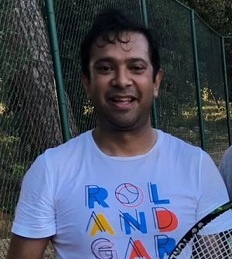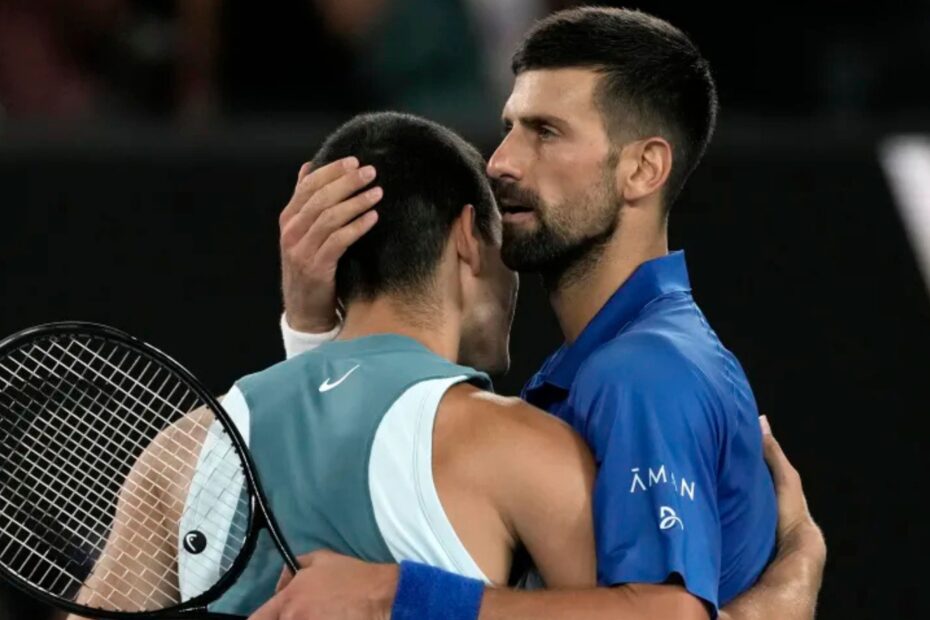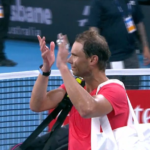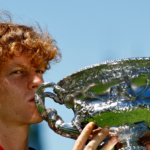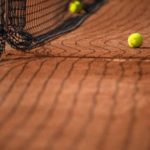Novak Djokovic and Carlos Alcaraz faced off in a much-anticipated quarterfinal at the 2025 Australian Open, and the match didn’t disappoint. Djokovic, at 37, fought through injury and an early deficit to defeat the 21-year-old Alcaraz in four sets: 4-6, 6-4, 6-3, 6-4. While Alcaraz started strong, even taking the first set, Djokovic’s experience and adaptability ultimately made the difference. The match had everything—long rallies, dramatic momentum shifts, and key moments that highlighted both players’ strengths and weaknesses.
Alcaraz later admitted that his biggest mistake was not capitalizing on Djokovic’s apparent struggles in the second set. Djokovic, on the other hand, credited his resilience and strategic adjustments for turning things around. This quarterfinal wasn’t just another win for Djokovic—it moved him one step closer to a record 25th Grand Slam title, while giving Alcaraz valuable lessons as he continues to grow as a player. Here’s a breakdown of the match and what it means for both players.
How Alcaraz Let the Match Slip Away
Carlos Alcaraz began the match with confidence, winning the first set by exploiting his speed, shot variety, and well-placed serves. When Djokovic took a medical timeout late in the first set to address a leg issue, Alcaraz appeared poised to take control. However, this moment ended up being a turning point for the wrong reasons.
In the second set, Alcaraz admitted to changing his approach. Seeing Djokovic’s physical discomfort, he eased up, believing the match was about to get easier. “I thought I had him,” Alcaraz said after the match. “I felt like I was controlling things and let him back into it.”
This change in mindset allowed Djokovic to recover. Instead of pushing Djokovic to the limit, Alcaraz became cautious, which played directly into the veteran’s hands. Once Djokovic leveled the match at one set apiece, momentum started shifting. Alcaraz found himself in increasingly tight situations as Djokovic ramped up the pressure.
Djokovic’s Comeback: Experience and Strategy at Work
For Djokovic, the match was about survival early on. His physical discomfort was evident, and by his own admission, he considered retiring had he lost the second set. “If I lost that second set, I don’t know if I would continue playing,” Djokovic said after the match.
But once he secured the second set, Djokovic’s level improved dramatically. He began targeting Alcaraz’s serve with aggressive returns and shortened rallies by taking control early. Painkillers administered during the medical timeout also helped him move more freely, allowing him to cover the court effectively.
Key moments in the match included a 33-shot rally in the fourth set, which drew gasps from the crowd, and a remarkable defensive lob Djokovic chased down to clinch the third set. His ability to stay composed in high-pressure points and execute his game plan ultimately gave him the edge.
A Match of Contrasting Strengths
This match highlighted the different strengths of both players. Alcaraz brought energy and creativity, with drop shots and booming forehands that kept Djokovic guessing in the first set. His ability to mix up play showed why he’s been able to beat Djokovic on other occasions. However, his inexperience at this stage was evident in the second set, when he failed to maintain focus and capitalize on Djokovic’s vulnerability.
Djokovic, in contrast, relied on his experience and mental toughness. Even as he struggled physically, he never wavered in his tactical approach. His consistency on crucial points and ability to dictate play when it mattered most demonstrated why he’s been so dominant in his career.
Key Stats from the Match
- Longest Rally: A 33-shot exchange in the fourth set that ended in Alcaraz’s favor but highlighted both players’ endurance.
- Decisive Set: The second set was pivotal. Djokovic’s comeback shifted the momentum, setting the tone for the rest of the match.
- Crucial Breaks: Djokovic broke Alcaraz’s serve twice in the third set, including one break at the end of a 22-shot rally.
What’s Next for Djokovic and Alcaraz?
With this win, Djokovic advanced to his 50th Grand Slam semifinal, where he’ll face Alexander Zverev. Djokovic will need to recover quickly, as his leg injury could still play a role in the next round. If he can maintain this level of play, he’s well-positioned to chase his 25th Grand Slam title.
For Alcaraz, this loss will sting, but it’s part of the learning curve for a young player who has already achieved so much at just 21 years old. Reflecting on the match, Alcaraz acknowledged the lessons he could take forward. “These matches are experiences that help me grow,” he said. “I’ll be better prepared next time.”
Despite the defeat, Alcaraz remains one of the brightest stars in tennis and will likely use this experience as motivation for the rest of the season.
The Bigger Picture
This quarterfinal offered a glimpse into the present and future of tennis. Djokovic continues to prove why he’s one of the greatest players in history, while Alcaraz is solidifying himself as the face of the next generation. The match also highlighted the mental and physical demands of competing at this level, as well as the fine margins that separate victory from defeat.
